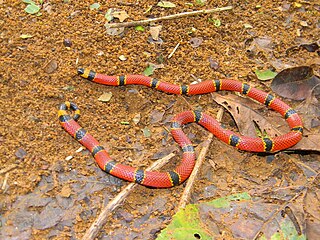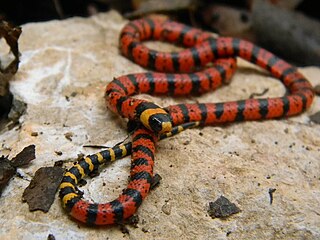
Coral snakes are a large group of elapid snakes that can be divided into two distinct groups, the Old World coral snakes and New World coral snakes. There are 27 species of Old World coral snakes, in three genera, and 83 recognized species of New World coral snakes, in two genera. Genetic studies have found that the most basal lineages have origins in Asia, suggesting that the group originated in the Old World. While new world species of both genera are venomous, their bites are seldom lethal; only two confirmed fatalities have been documented in the past 100 years from the genus Micrurus. Meanwhile, snakes of the genus Micruroides have never caused a medically significant bite.

Micrurus is a genus of venomous coral snakes of the family Elapidae.

Micrurus tener, commonly known as the Texas coral snake, is a species of venomous snake in the family Elapidae. The species is native to the southern United States and adjacent northeastern and central Mexico. Six subspecies are recognized as being valid, including the nominotypical subspecies, Micrurus tener tener The species Micrurus tener was once considered to be a subspecies of the eastern coral snake.

Micrurus hemprichii, commonly known as Hemprich's coral snake and the worm-eating coral snake, is a species of venomous coral snake in the family Elapidae. The species is native to South America.

Micrurus nigrocinctus, commonly known as the Central American coral snake, is a species of a highly venomous snake in the family Elapidae. The species is endemic to Latin America from southern Mexico, Central America, to north Colombia. There are six recognized subspecies, including the nominate subspecies described here.

Micrurus stuarti is a species of venomous snake in the family Elapidae. The species is endemic to Guatemala. There are no recognized subspecies.

Micrurus browni, commonly known as Brown's coral snake, is a species of venomous snake in the family Elapidae. The species is native to Guatemala and southwestern Mexico. There are three recognized subspecies, including the nominate subspecies described here.

The Brazilian coral snake is a species of coral snake in the family Elapidae.

Bogert's coral snake is a species of venomous snake in the family Elapidae. The species is endemic to southern Mexico.

Micrurus lemniscatus, commonly known as the South American coral snake, is a species of venomous snake in the family Elapidae. The species is endemic to South America.

Micrurus diastema, commonly known as the variable coral snake, is a species of venomous snake in the family Elapidae. The species is endemic to southeastern Mexico and northern Central America. There are seven recognized subspecies.

Micrurus annellatus, commonly known as annellated coral snake, is a species of venomous elapid snake native to southeastern Ecuador, eastern Peru, Bolivia, and western Brazil. There are three recognized subspecies, including the nominate subspecies described here.

Micruroides is a genus of venomous coral snake in the family Elapidae. The genus is monotypic, containing only the species Micruroides euryxanthus.
Jānis Arnolds Roze, born in Latvia in 1926, is a herpetologist and Professor of Biology Emeritus of City College and Graduate School of the City University of New York. He was professionally associated with the American Museum of Natural History and the United Nations. A founder of the International Center for Integrative Studies, he published several books and narrated several videos on Creative Evolution. He co-edited What Does it Mean to Be Human.

Micrurus mipartitus is a species of coral snake in the family Elapidae. The species is native to Central America and northern South America. The red-tailed coral snake is common in agricultural areas in Colombia. Its highly neurotoxic venom is known to cause seizures in its prey by activating nerve proteins responsible for seizures within it.
Micrurus helleri, also known commonly as Heller's coral snake and the western ribbon coral snake, is a species of venomous snake in the family Elapidae. The species is native to South America.

Micrurus narduccii, the Andean blackback coral snake, is a species of snake of the family Elapidae.

Micrurus obscurus, the black-neck Amazonian coral snake or Bolivian coral snake, is a species of snake of the family Elapidae.

Micrurus serranus is a species of snake of the family Elapidae.

Micrurus spixii, the Amazon coral snake, is a species of snake of the family Elapidae.



















